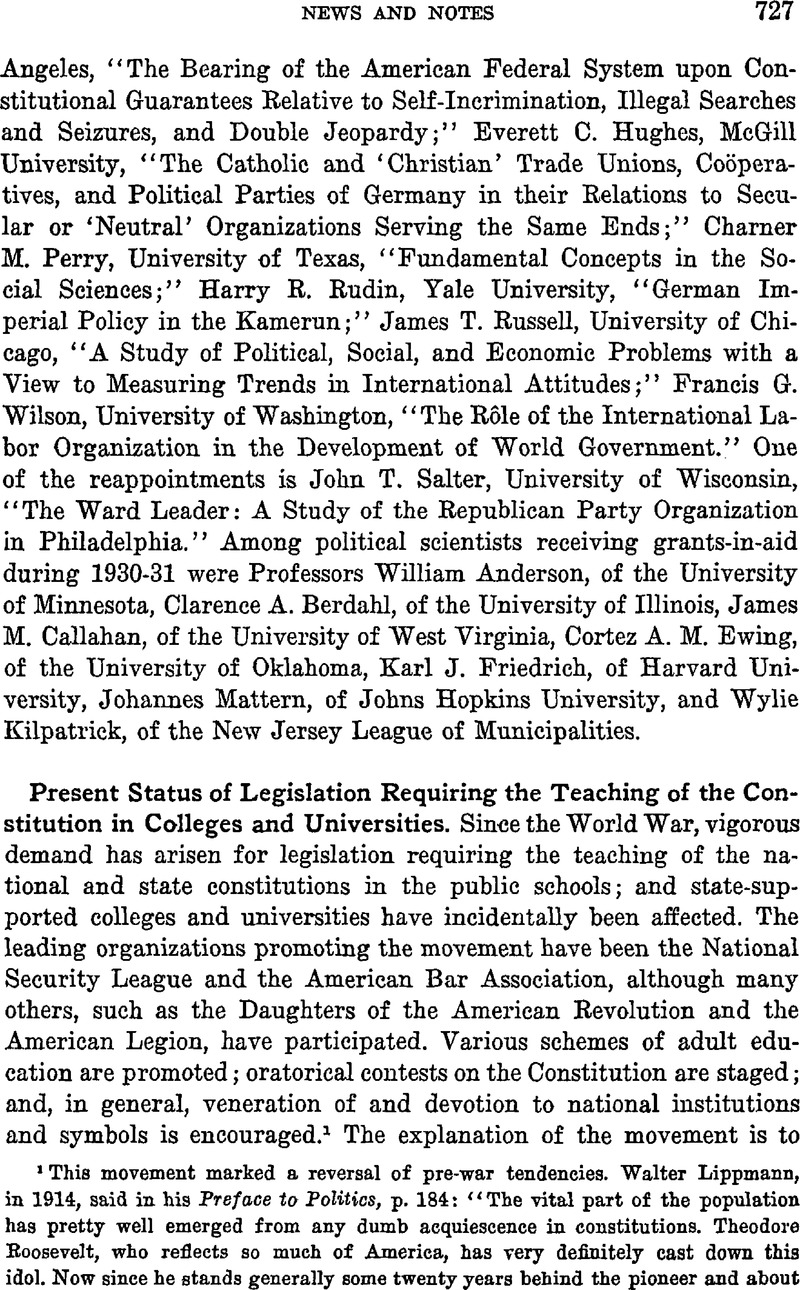No CrossRef data available.
Published online by Cambridge University Press: 01 August 2014

1 This movement marked a reversal of pre-war tendencies. Lippmann, Walter, in 1914, said in his Preface to Politics, p. 184Google Scholar: “The vital part of the population has pretty well emerged from any dumb acquiescence in constitutions. Theodore Roosevelt, who reflects so much of America, has very definitely cast down this idol. Now since he stands generally some twenty years behind the pioneer and about six months ahead of the majority, we may rest assured that this much-needed icono-clasm is in process of achievement.” For a reasoned defense of the movement, see Hart, A. B., “‘Instilling’ the Constitution,” Current History, XXVII, pp. 104–105 (1927)Google Scholar.
2 The committee on American citizenship of the American Bar Association said that the issue was very clearly drawn between “stability and radicalism; between the forces of real progress and retrogression; between a government under a written constitution as established by our fathers and a government by the mob—or, if you please, the proletariat….” Reports, American Bar Association, 1923, p. 442Google Scholaret seq.
3 Reports, American Bar Association, 1924, p. 255Google Scholaret seq. See also other statements of the committee published in the Reports.
4 For accounts of the movement and its results, with special reference to the public schools, see Pierce, Bessie L., Public Opinion and the Teaching of History in the United States, 184–205 (1926)Google Scholar, and Civic Attitudes in American School Textbooks, 229–241 (1930)Google Scholar.
5 In Connecticut (not included in this number), it is required that normal colleges shall offer courses in the duties of citizenship, including a knowledge of national, state, and local government. General Statutes, Sec. 836 (1930).
6 Of the twenty-three states, seven (Ariz., Ark., Calif., Fla., S.C., Tex., and Wyo.) which do not directly require the instruction to be offered in private colleges probably achieve the same end indirectly by an incidental provision of the law prescribing that applicants for teachers' certificates shall have passed an examination upon the principles and provisions of the Constitution, or have had a course upon the subject. In those states where the law is applicable only to the lower schools, but incidentally requires the passage of an examination upon the Constitution for a teacher's certificate, the curricula of both state and private colleges are probably affected.
7 Letter to writer, April 15, 1931. The Arkansas statute follows practically verbatim the No. 1 bill of the National Security League. See General Acts, extraordinary sess., 44th General Assembly of Arkansas, pp. 170-172 (1923).
8 The alternative draft proposed by the League was adopted almost verbatim in Colorado, among other states. See Laws, 25th sess., General Assembly of Colorado, Ch. 151 (1925).
9 See Rules and Regulations of the State Board of Education (Bulletin F-1, Sacramento, 1930)Google Scholar.
10 Letter from assistant state superintendent to the writer, April 28, 1931.
11 So far as is known, no energetic effort has been made by these agencies to influence the attitudes of college instructors. But with reference to secondary schools, see the report of a committee of the Illinois Bar Association reprinted by the American Bar Association in The Constitution and the Schools.
Comments
No Comments have been published for this article.